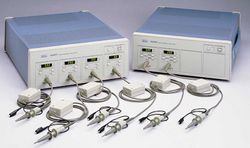A6907
The Tektronix A6907 / A6909 High Voltage Isolators connect “floating” (not referenced to ground) signals to an oscilloscope or digitizer for measurement.
The A6907 has four, the 6909 has two input channels.
The A6907/A6909 include special probes with an in-cable balun for shielding against large dv/dt fields. These probes are specific to the A6907/A6909.
Optionally, an A620 current probe can be connected.
Key Specifications
| Bandwidth | DC to 60 MHz (100 and 200 mV ranges: 50 MHz) |
|---|---|
| Deflection | 100 mV/Div to 200 V/Div, 1-2-5 (scope input @ 100 mV/Div) |
| Normal mode voltage | max. 850 V (DC + peak AC) |
| Common mode voltage (channel to chassis) | 850 V (DC + peak AC) or 600 V (ACRMS); derate at 20 dB/decade from 500 kHz to 60 MHz |
| Common mode voltage (between channels) | 1700 V (DC + peak AC) or 1200 V (ACRMS) |
| CMRR | 105 dB @ 60 Hz, 60 dB @ 1 MHz, 50 dB @ 10 MHz |
| Common mode slew rate | 20 kV/ms |
| Features |
|
Internals
Optical couplers, insulated transformers, and plastic barriers are used for extremely high isolation between channels and the chassis, and from channel to channel.
An electrical-to-optical (E/O) converter isolates the signal and converts it to an optical analogue. An optical-to-electrical (O/E) converter demodulates the optical signal to an electrical signal whose common mode elements have been rejected. The E/O converter uses a low-contact DC to DC converter as a power source to provide a high degree of isolation.
-
A6907
-
A6907
-
A6907
-
A6907
-
A6909
-
A6909






